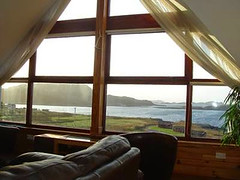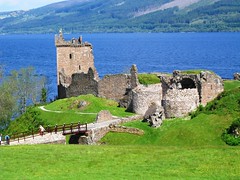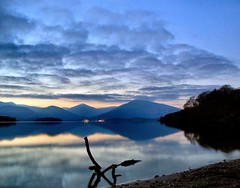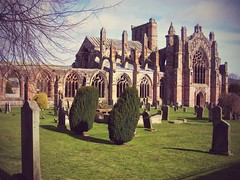Drink In Scotland
Contents |
Beer
Food in Scotland | Drinking in Scotland
Beer is the staple alcoholic drink in Scotland. The most popular type of beer is lager, but connoisseurs should sample one of the many excellent types of heavy, which is a thick, dark ale served at room temperature with a full, creamy head. Types of heavy are graded by the shilling, which indicates its strength; the higher the number the stronger the beer. The usual range is 60 to 80 shillings (written 80/-). The best ales are hand-pumped from the cask under pressure. Beer is served in pints, or half pints, and you'll pay between £1.50 and £2.50 for a pint, depending on the brew and location of the pub.
The market is dominated by the large brewers - Youngers, McEwan's, Scottish & Newcastle and Tennet's. They produce smooth, strong beers, but the country's best seller is, strangely enough, Tartan Special, which is weak and tasteless by comparison.
For the best of Scottish beers, however, you should try one of the small local breweries. Edinburgh's Caledonian produces a wide range of excellent cask ales. Others worth trying are Belhaven, brewed in Dunbar near Edinburgh, Maclays, brewed in Alloa, and the very wonderful Greenmantle, brewed in the Borders.
Whisky
No visit to Scotland would be complete without availing oneself of a 'wee dram'. There is no greater pleasure on an inclement Highland evening than enjoying a malt whisky in front of a roaring log fire whilst watching the rain outside pelt down relentlessly.
The roots of Scotland's national drink (uisge beatha, or 'water of life' in Gaelic) go back to the late 15th century, but it wasn't until the invention of a patent still in the early 19th century that distilling began to develop from small family-run operations to the large manufacturing business it has become today. Now more than 700 million bottles a year are exported, mainly to the United States, France, Japan and Spain.
There are two types of whisky: single malt, made only from malted barley; and grain, which is made from malted barley together with unmalted barley, maize or other cereals, and is faster and cheaper to produce.
Most of the popular brands are blends of both types of whisky - usually 60-70% grain to 30-40% malt. These blended whiskies account for over 90% of all sales worldwide, and most of the production of single malts is used to add flavour to a blended whisky.
Amongst the best-known brands of blended whisky are Johnnie Walker, Bells, Teachers and Famous Grouse. There's not much between them in terms of flavour and they are usually drunk with a mixer, such as water or soda.
Single malts are a different matter altogether. Each is distinctive and should be drunk neat to appreciate fully its subtle flavours, though some believe that the addition of water helps free the flavours. Single malts vary enormously. Their distinctive flavours and aromas are derived from the peat used for drying, the water used for mashing, the type of oak cask used and the location of the distillery.
Single malts fall into four groups: Highland, Lowland, Campbeltown and Islay. There are over 40 distilleries to choose from, most offering guided tours. The majority are located around Speyside, in the northeast. The region's many distilleries include that perennial favourite, Glenfiddich, which is sold in 185 countries. A recommended alternative is the produce of the beautiful and peaceful Isle of Islay, whose malts are lovingly described in terms of their peaty quality.
Scots tend to favour the 10 year-old Glenmorangie, while the most popular in the USA is The Macallan.
Which whisky?
Opinions vary as to what are the best single malts and as to when you should drink them. As a rough guide, I would recommend a Speyside malt such as Glenmorangie or Glenlivet before dinner and one of the Islay malts - Ardbeg, Bowmore, Bunnahabhain (pronounced 'bun-a-haven'), Lagavulin, or the very wonderful Laphroaig (pronounced 'la-froig') - after dinner.
If the Islays are not to your taste, then you could try instead Highland Park from Orkney or perhaps Tamdhu or Aberlour from Speyside. Those eternal favourites, Glenfiddich and The Macallan, can be enjoyed at any time.
How malt whisky is made
Malt whisky is made by first soaking dry barley in tanks of local water for two to three days. Then the barley is spread out on a concrete floor or placed in cylindrical drums and allowed to germinate for between eight and 12 days, after which it is dried in a kiln, heated by a peat fire. Next, the dried malt is ground and mixed with hot water in a huge circular vat called a 'mash tun'. A sugary liquid called 'wort' is then drawn from the porridge-like result and piped into huge containers where living yeast is stirred into the mix in order to convert the sugar in the wort into alcohol. After about 48 hours the 'wash' is transferred to copper pot stills and heated till the alcohol vaporizes and is then condensed by a cooling plant into distilled alcohol which is passed through a second still. Once distilled, the liquid is poured into oak casks and left to age for a minimum of three years, though a good malt will stay casked for at least eight years.








